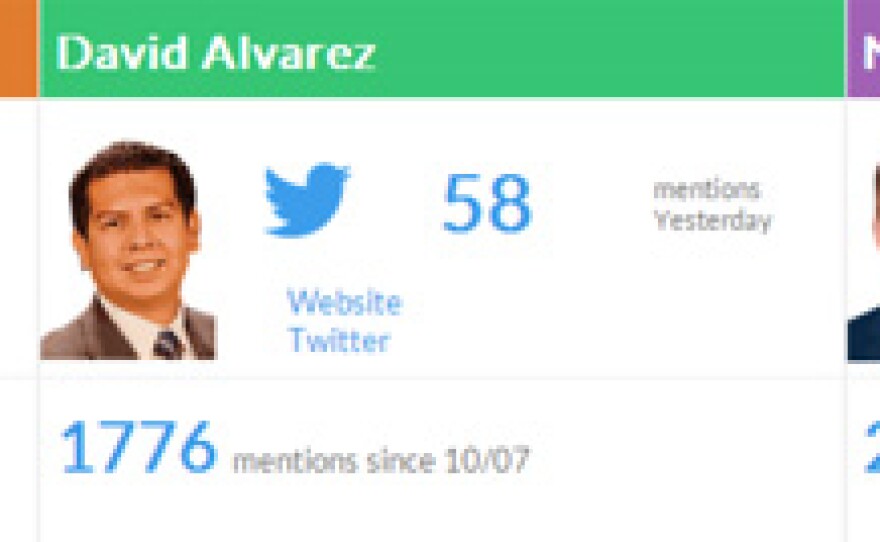This past October, professor Ming-Hsiang Tsou of SDSU’s geography department, along with colleagues and research students, created an interactive online tool called “ElectionPath.” Tsou believed, based on his previous work, that Twitter buzz could successfully predict San Diego’s next mayor.
So did it work?
Yes. And no.
It depends on how you look at the data. When analyzed over the course of the six weeks it operated, ElectionPath didn’t predict the winners completely. It always had mayoral candidate Kevin Faulconer as the frontrunner, but showed Nathan Fletcher in second place for total Twitter mentions.
But when it came down to the final days of the campaign, ElectionPath showed a marked change: David Alvarez’s Twitter mentions caught up with Fletcher’s around Nov. 10, and on Nov. 19, Alvarez surged ahead - in tweets and ultimately in votes.
Predicting an election through social media analysis is a new field of study relatively and has yet to gain anything close to universal acceptance. Supporters undoubtedly will see proof in Tsou’s results, while critics have just as much to go on. Given the rapid growth in social networking both in the U.S. and worldwide, it’s no surprise researchers and academics like Tsou are crunching data by the ton, looking for the next big breakthrough in cheap, up-to-the-minute public polling.
To get at these prediction factors, Tsou’s ElectionPath takes into account daily changes in the number of each candidate’s followers, their online mentions and even the geolocation of relevant tweets.
His theory behind the application came on the heels of a similar case study he and others produced in November 2012 called “Mapping social activities and concepts with social media…” Tsou and colleagues analyzed thousands of web pages and millions of tweets related to the presidential election between Barack Obama and Mitt Romney. The resulting data showed Obama leading in the final days before the election.
Tsou and his collaborators wrote,
“This new approach may provide a new research direction for studying human thought, human behaviors and social activities quantitatively.”
One year later, Tsou pointed to the ElectionPath statistics for the day prior to the San Diego election.
On that day, Kevin Faulconer — who ended up garnering the most votes — was head and shoulders above the other three candidates in both primary categories: “mentions yesterday” and “mentions since Oct. 7” (the day ElectionPath began gathering data).
David Alvarez, who placed second on Nov. 20, was behind Faulconer but slightly ahead of candidate Nathan Fletcher in “mentions yesterday,” although he lagged significantly behind Fletcher in the “mentions since Oct. 7” category.
If based solely on “mentions yesterday” during the last days of the mayoral race, ElectionPath results strongly correlate to the Nov. 20 outcome.

Faulconer election results: 42 percent
Alvarez election results: 27 percent
Fletcher election results: 24 percent
But if the prediction power lies only in the “mentions yesterday” category, what’s with all the other bells and whistles such as “top followers,” “top retweets” and the “word cloud map”? And why bother setting up the application more than a few days before an election if all that matters is the final stretch?
The reason, according to Tsou, is that the extras aren’t geared toward the general public. They’re meant for the campaign managers — and campaign dollars — he and his colleagues hope to attract. The idea is that strategists will pay top dollar for a data-based big picture of their campaign; one which shows daily trends not only for their own candidate but also for the opposition. Which key messages are resonating with voters? Which are not? Which followers should a campaign target to help spread their message?
Not surprisingly, Gabriel Solmer — David Alvarez’s campaign manager — has emailed Tsou already to learn more about ElectionPath.
As stated in the previous story, inewsource is a partner of SDSU and a supporter of emerging technologies. We hosted ElectionPath on our site with a strong disclaimer: We are not social scientists. Even though Tsou believes his technology to be accurate, we’d need to see many more trials before agreeing. But we are interested in following Tsou’s work, and believe our readers may be, as well.
An an aside, recently Tsou became the director and founder of the Center for Human Dynamics and Decision Support, a new multidisciplinary research collaborative at SDSU. The center, called H2D, will promote collaboration between four different departments — public health, geography, sociology and communication — with the aim of utilizing big data to monitor, visualize and analyze human dynamics.
inewsource is an independent nonprofit partnered with KPBS. Learn more here.






